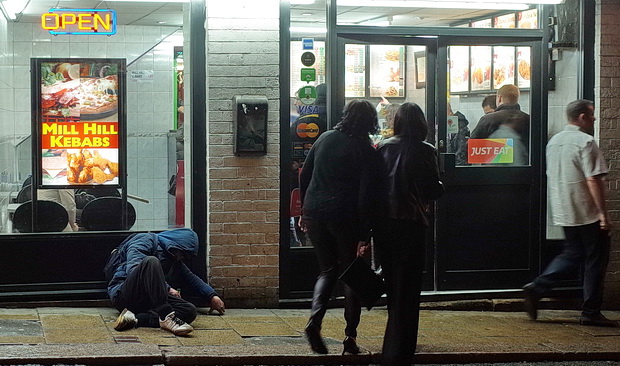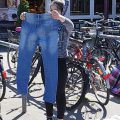
Here’s a collection of photos taken during a short visit to Leeds earlier this month.
Standing on the site of a moated medieval manor house that was rebuilt in 1765 as a most desirable residence, Henry Scarbrough took over this central Leeds property in 1826, at which point it became the Kings Arms.
In the late 1890s, Fred Wood established The Scarbrough Hotel pub which became a noted fixture on the Music Hall circuit.
I was in Leeds to play the Brudenell Social Club which is located about a mile out from the centre in the Hyde Park area.
The streets surrounding the venue are traditional back-to-back Victorian terraces, with confusingly similar names. Running off Thornville Road can be found Harold Terrace, Harold Place, Harold Grove, Harold Street, Harold Mount, Harold View, Harold Road, Harold Walk and Harold Avenue!
The Brudenell Social Club is a wonderful venue, run as a non-profit organisation while retaining the “community atmosphere of its origins as a working men’s club”.
The club was originally formed in 1913 by local businessmen, who built a wooden clubhouse which was replaced by the present brick building in 1978.
Now a major venue on the gig circuit, it’s played host to gigs by the likes of Kaiser Chiefs, Franz Ferdinand, The Cribs, The Wedding Present and The Fall.
The club is split into three areas, a 400 capacity concert room, a bar area and games room section and a second concert area, known as the Community Room, which opened in 2017.
I was playing the Brudenell with The Monochrome Set – here’s my kit for the night (complete with my usual fairly lights and essential cowbell fixtures).
Quick snap during a lull in the tub-thumping.
We repaired to the North Bar for after show drinks.
It’s a fine late night bar, with a handsome choice of ales.
Leeds at night.
My diary says: “Boy oh boy do some people get hammered in Leeds on a Friday night. It was like being back in Cardiff!”
I had a few hours to kill before my train to the next show, so went on a high speed saunter around the town, photographing a large anti-Brexit rally and march on my way.
River Aire.
City views.
The Leeds Corn Exchange is an outrageously handsome and extravagant structure.
Designed by Cuthbert Brodrick, this Grade I listed structure was completed in 1862 and opened on 28 July 1863.
The stunning dome design was based on that of the Bourse de commerce of Paris by François-Joseph Bélanger and François Brunet, which was completed in 1811.
Leeds Corn Exchange is now just one of three corn exchanges in the country which operates in its traditional capacity as a centre for trade, albeit no longer for trading in corn.
Graeme Wilson’s 1990s public art on Call Lane depicts the Roman Goddess of Abundance, Victorian townspeople, fresh produce and a Cherub clutching a bread basket. It went to win the Leeds Award for Architecture and the Environment.
More street scenes.
The largest covered market in Europe, Kirkgate Market hosts 800 stalls which attract over 100,000 visitors a week
In 1884, Kirkgate Market was the founding location of Marks & Spencer which opened in Leeds Market as a penny bazaar, and that heritage is marked by the Market Clock in the 1904 hall which bears the shop’s name.
I always used to think the quaint arcades in my hometown of Cardiff were pretty special but have to admit that the ones in Leeds are of an altogether grander and more impressive nature.
Old and new architecture.
Street vendor.
Known as ‘The Barrelman’ this cheerful figure stands outside the St John’s Centre, and was a gift from Leeds’ twin town Dortmund in 1980.
On temporary loan to the city, the 5-metre high ‘Legs Walking’ sculpture is by Leeds-born sculptor Kenneth Armitage and is situated close to the railway station.
Leeds station is a miserable modern affair, burrowed under a shiny modern block.


